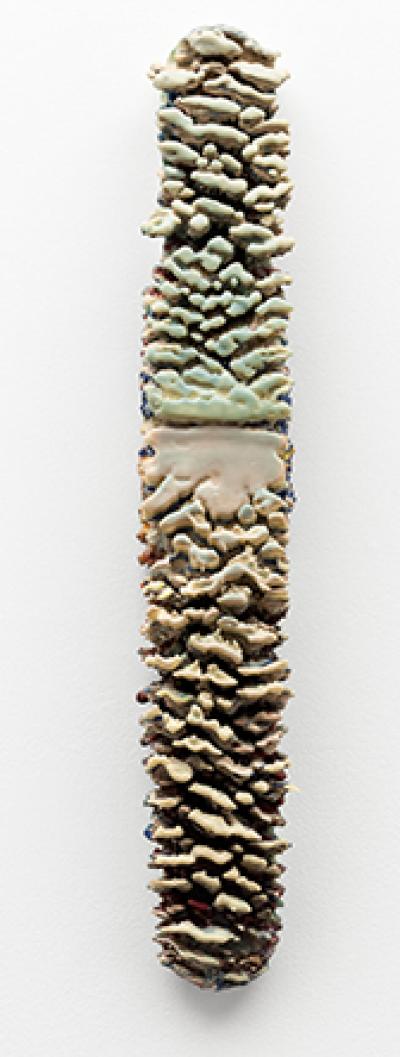Through a Feminine Gaze

A permanent collection show that opened at the Museum of Modern Art last week reveals the result of several decades of commitment to acquiring art objects created by women. “Making Space: Women Artists and Postwar Abstraction” spans the years following World War II through the late 1960s and underlines the primacy of those early female abstract painters who found their way to the South Fork in those decades.
Beckoning visitors to the exhibition from just outside its entrance, Grace Hartigan’s bold “Shinnecock Canal” from 1957 holds a large white expanse of wall with its bold greens, blues, and reds. The painting heralds the strong contributions by previous South Fork denizens such as Hedda Sterne (in the entrance hall), Joan Mitchell, Lee Krasner, Elaine de Kooning, and Helen Frankenthaler in the first room of the exhibition.
These are achievements notable for the time in which they were created. Having to hold their own in a medium and style defined by masculinity, female Abstract Expressionists had to fight for their work to be shown and considered on equal terms, as the curators, Starr Figura and Sarah Meister, noted in their wall text. “Efforts to recover and reconsider these artists’ works are still ongoing 60 years later,” they concluded.
These efforts can be seen in gallery shows, art fairs, and museum exhibitions over the past decade. Dealers are finding that superior works still in private hands can be had at prices reasonable by art market standards. But when MoMA unleashes its own collection for the purpose, it is astounding.
Since the show chronicles some 30 years, the early period, with the strongest South Fork ties, is just a fraction of the other work by international artists in mediums such as photography, fiber art, collage, and sculpture. Yet, these early paintings overwhelm the space, with their commanding presence and demonstration of how pivotal their creators were in forging a path for those who followed.
Ms. Figura said at a press preview on Tuesday that Ms. Meister and she were asked to collaborate on some aspect of MoMA’s midcentury collection. They combed the collection’s database for every artwork made between 1940 and 1970. “What struck us both were how many really amazing works there were by women artists, and that many of them were acquired in the last 15 years or so and had not been on view.”
The Abstract Expressionist works here were mostly acquired near the time of their completion, and have been included in installations of the collection and in recent special exhibitions. Yet they, too, were often relegated to long periods in storage during the intervening years.
Ms. Figura said that after the war there was a return to established gender roles after women had taken on many of the jobs men had vacated to go fight. Women artists found that they, too, were expected to conform to the traditional duties of a wife in supporting the work of their artist husbands, who were typically more famous than they were.
These women had “to make space for themselves in painting and sculpture, within a tradition that has been dominated by men for centuries, and in this particularly masculine movement,” she said at the press preview.
Ms. Meister added that it often took divorce or the death of their husbands for these artists “to step into the foreground of their own practices.”
With the social upheaval of the 1960s, many of the previous constraints were removed. According to Ms. Figura, women began “reclaiming notions of craft and the use of unorthodox materials and techniques as a way of finding another space outside of the traditional hierarchies that were difficult for women to navigate previously.”
Indeed, Ms. Meister said that by the last gallery of the show she and Ms. Figura realized that they did not even know whether those later artists were married and whether it even mattered or if they cared.
Lee Bontecou, who lived in East Hampton from 1971 and 1973, is one of these later artists. Her untitled sculpture from 1961 combines welded steel, canvas from discarded conveyer belts, fabric, rawhide, soot, and wire to create a three-dimensional, wall-mounted object that aggressively enters the viewers’ space and draws them in to the circular void she has positioned at the work’s center.
The museum’s label for the object notes that the work was created the same year as the Bay of Pigs, the construction of the Berlin Wall, and the first commitment of United States troops to Vietnam. The artist wrote at the time that she wanted to build things to show “some of the fear, hope, ugliness, beauty, and mystery that exists in us all and which hangs over all the young people today.”
Lynda Benglis, a resident of East Hampton since 1985, also has a wall sculpture in the show. Her “Embryo II” from 1967 is one of several works the artist made from beeswax, resin, and gesso on Masonite scaled to the length of her arm. The result was a “craggy topography” that she then exaggerated with the use of a blowtorch.
Both of these later artists found no difficulty in taking the prevailing artistic trend at the time, in their case Minimalism, and adapting it to their own aesthetic and aims. Ms. Benglis reacted to both the austerity of Minimalism and the seriousness and self-importance of Abstract Expressionism in her use of unusual materials, references to the body, and subversive wit, as the curators pointed out.
The show is on view through Aug. 13.
